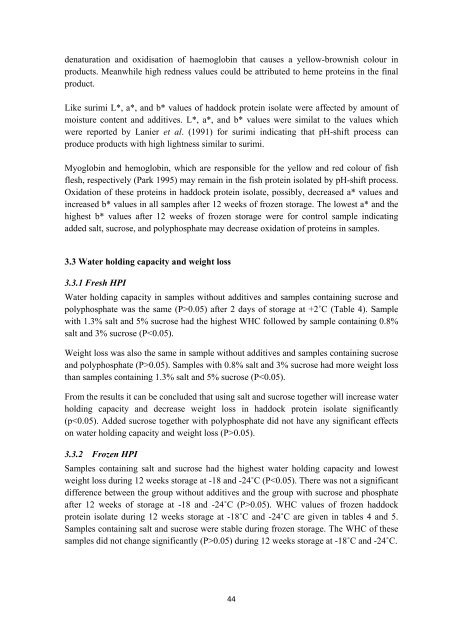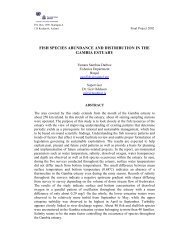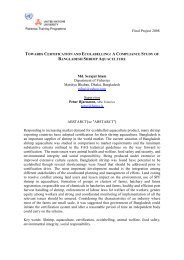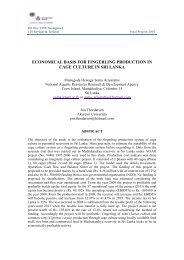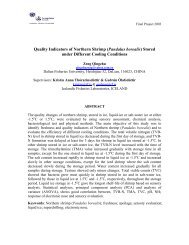Evaluation and Utilisation of Fish Protein Isolate Products
Evaluation and Utilisation of Fish Protein Isolate Products
Evaluation and Utilisation of Fish Protein Isolate Products
- No tags were found...
Create successful ePaper yourself
Turn your PDF publications into a flip-book with our unique Google optimized e-Paper software.
denaturation <strong>and</strong> oxidisation <strong>of</strong> haemoglobin that causes a yellow-brownish colour inproducts. Meanwhile high redness values could be attributed to heme proteins in the finalproduct.Like surimi L*, a*, <strong>and</strong> b* values <strong>of</strong> haddock protein isolate were affected by amount <strong>of</strong>moisture content <strong>and</strong> additives. L*, a*, <strong>and</strong> b* values were similat to the values whichwere reported by Lanier et al. (1991) for surimi indicating that pH-shift process canproduce products with high lightness similar to surimi.Myoglobin <strong>and</strong> hemoglobin, which are responsible for the yellow <strong>and</strong> red colour <strong>of</strong> fishflesh, respectively (Park 1995) may remain in the fish protein isolated by pH-shift process.Oxidation <strong>of</strong> these proteins in haddock protein isolate, possibly, decreased a* values <strong>and</strong>increased b* values in all samples after 12 weeks <strong>of</strong> frozen storage. The lowest a* <strong>and</strong> thehighest b* values after 12 weeks <strong>of</strong> frozen storage were for control sample indicatingadded salt, sucrose, <strong>and</strong> polyphosphate may decrease oxidation <strong>of</strong> proteins in samples.3.3 Water holding capacity <strong>and</strong> weight loss3.3.1 Fresh HPIWater holding capacity in samples without additives <strong>and</strong> samples containing sucrose <strong>and</strong>polyphosphate was the same (P>0.05) after 2 days <strong>of</strong> storage at +2˚C (Table 4). Samplewith 1.3% salt <strong>and</strong> 5% sucrose had the highest WHC followed by sample containing 0.8%salt <strong>and</strong> 3% sucrose (P0.05). Samples with 0.8% salt <strong>and</strong> 3% sucrose had more weight lossthan samples containing 1.3% salt <strong>and</strong> 5% sucrose (P0.05) during 12 weeks storage at -18˚C <strong>and</strong> -24˚C.44


